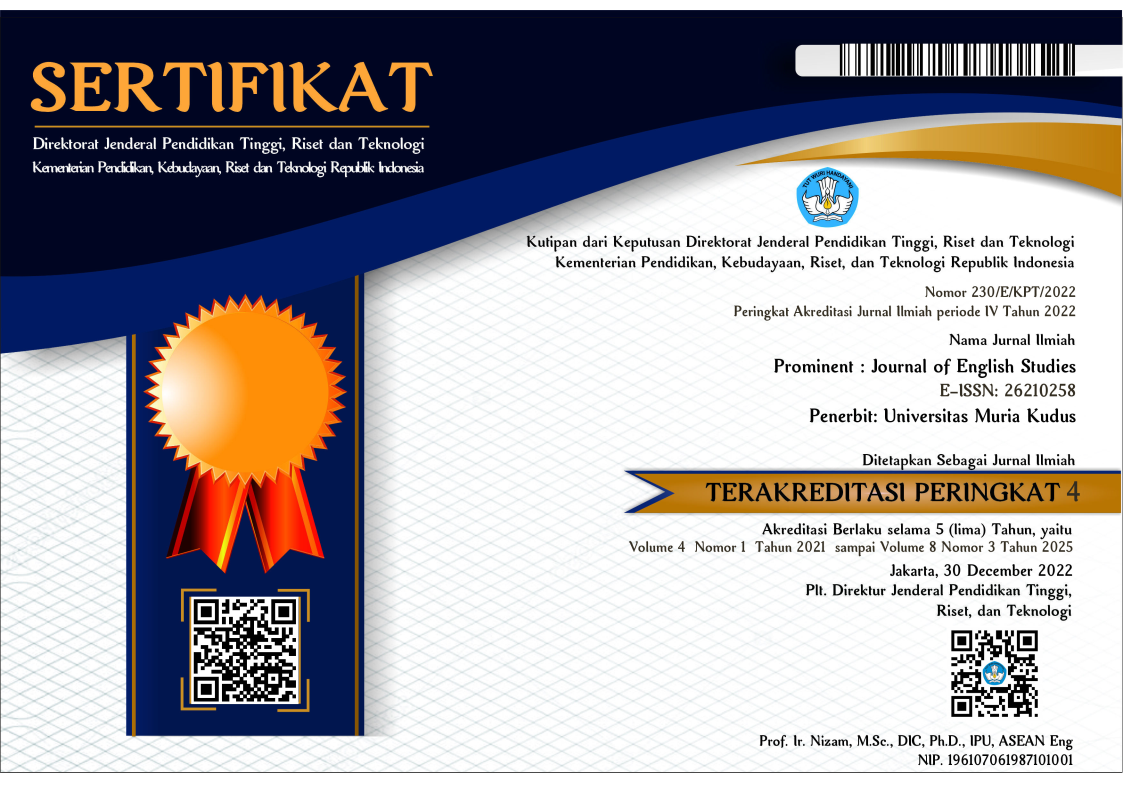RELATIONSHIP BETWEEN HIGHER-ORDER THINKING SKILLS (HOTS) AND ENGLISH ACHIEVEMENT
Abstract
Higher-order thinking skills (HOTS) is a new concept of thinking in Curriculum 2013 in Indonesia, which is based on the revised top three levels in Bloom’s Taxonomy: analyzing, evaluating, and creating. This survey research used 44 students who were purposively sampled. The objective of this research was to determine if there was a linear correlation between HOTS and the English achievement of the eleventh grade students of SMA N 2 Kudus. Using Pearson’s Product Moment Correlation in the level of significance .05 and degree of freedom 42, this research showed that there was a high positive significant linear correlation between HOTS and the English achievement of the eleventh grade students of SMA N 2 Kudus.
Key words: HOTS, taxonomy, curriculum 2013, English achievementKeywords
Full Text:
PDFReferences
Alsowat, Hamad. (2016). An EFL Flipped Classroom Teaching Model: Effects on English Language Higher-Order Thinking Skills, Student Engagement and Satisfaction. Journal of Education and Practice, 9(7), 108-121. Retrieved from: www.iiste.org.
Budsankom, Prayoonsri. (2015). Factors Affecting Higher Order Thinking Skills of Students: A Meta- analytic Structural Equation Modelling Study. Academic Journals, 10(9), 2639-2652. Retrieved from: http://www.academicjournals. org/ERR.
Kementrian Pendidikan Nasional. (2014). Permendiknas Nomor 70 Tahun 2014. Kerangka Dasar dan Struktur Kurikulum Sekolah Menengah Kejuruan/ Madrasah Aliyah Kejuruan.
Du, S., Fu, Z. Wang, Y. (2014). The FlippedClassroom- Advantages and Challenges. International Conference on Economic Management and Trade Cooperation, 17-20. doi: 10.2991/emtc-14.2014.3.
Frangenheim, E. 2006. Thinking Skills Framework. [online] Retrieved: 15 January, 2014. Available at: http://www.itcpublications.com.
Hasnor, Hanin Naziha., Ahmad, Zaiton, & Nordin, Norshidah. (2013). The Relationship between Learning Approach and Academic Achievement Among Intec Students, Uitm Shah Alam. Procedia: Social and Behavioral Sciences, 90, 178-186. Retrieved from: www.sciencedirect.com.
Kaur, Sajit & Ganapathy, Malini. (2014). ESL Students’ Perception of the Use of Higher Order Thinking Skills in English Language Writing. Australian International Academic Centre, 5(5), 80-87. Retrieved from: http://dx.doi.org/10.7575/aiac.alls.v.5n.5p.80.
Khan, Irshad Shaista. (2016). Critical Thinking in a Higher Education Functional English Course. Europan Journal of Educational Research, 9(7), 59-67. Retrieved from: www.iiste.org.
Margana. (2013). Empowering Students’ Creativity in Making sense of English texts with the Use of Higher Order Thinking Skills. Proceeding JETA Conference. Yogyakarta: Sahara Press.
Nadia, Siti. (2015). Teachers’ Perception on the Integration of HOTS in Language Teaching. International Journal of Technical Resaerch and Application, 22, 42-44. Retrieved from: www.ijtra.com.
Rusiana. (2016). Higher-Order Questions to Promote Critical Thinking. Proceeding: Teaching, Linguistic, Culture and Education, Conference, 156-163. Kudus: Badan Penerbit Universitas Muria Kudus.
Teemant, Annela. (2016). The Effects of Higher Order Thinking on Student Achievement and English Proficiency. ITJ, 13(1).
DOI: https://doi.org/10.24176/pro.v4i1.5791
Refbacks
- There are currently no refbacks.
Prominent Journal of English Studies is licensed under a Creative Commons Attribution-ShareAlike 4.0 International License.
Dedicated to:

in Collaboration with APSPBI:





